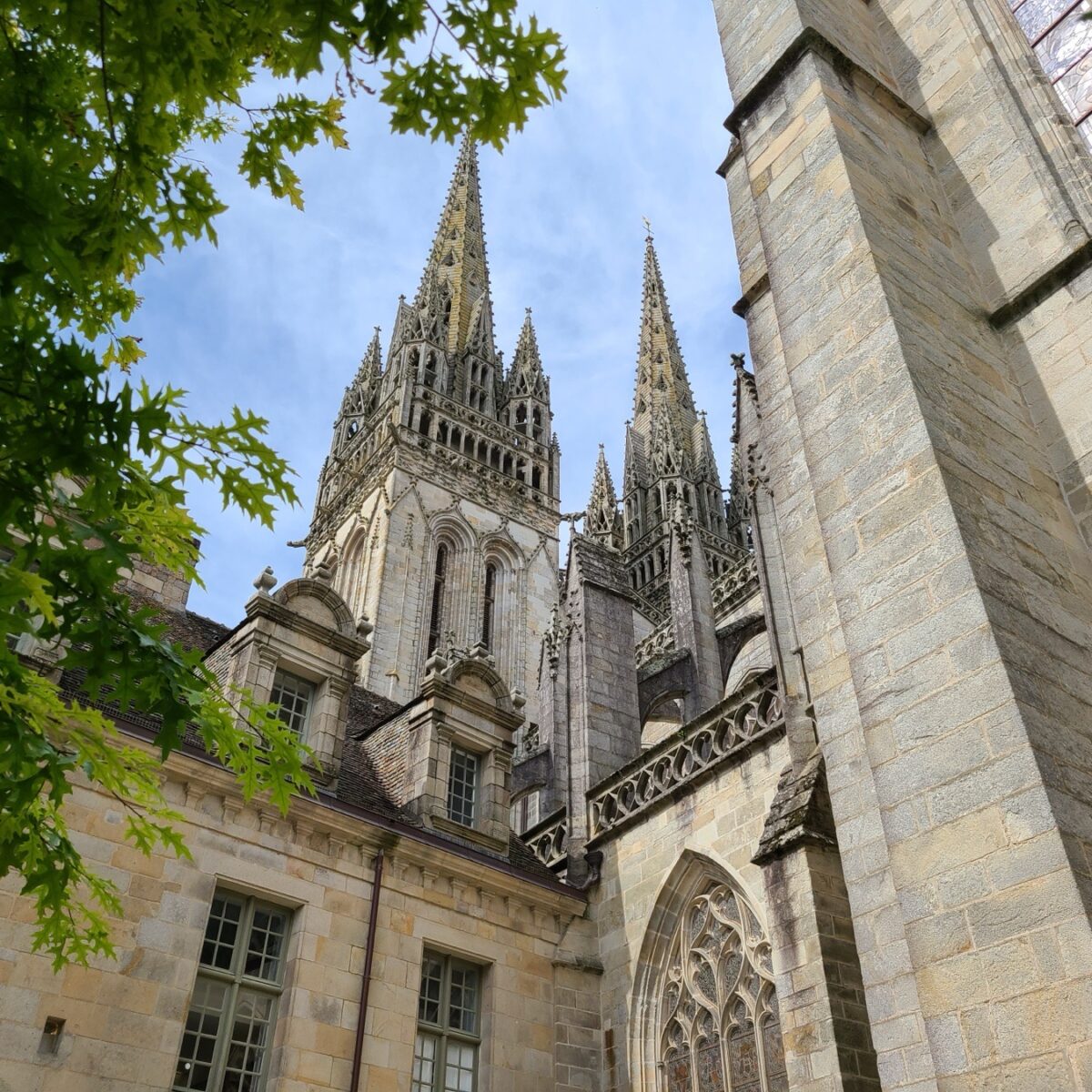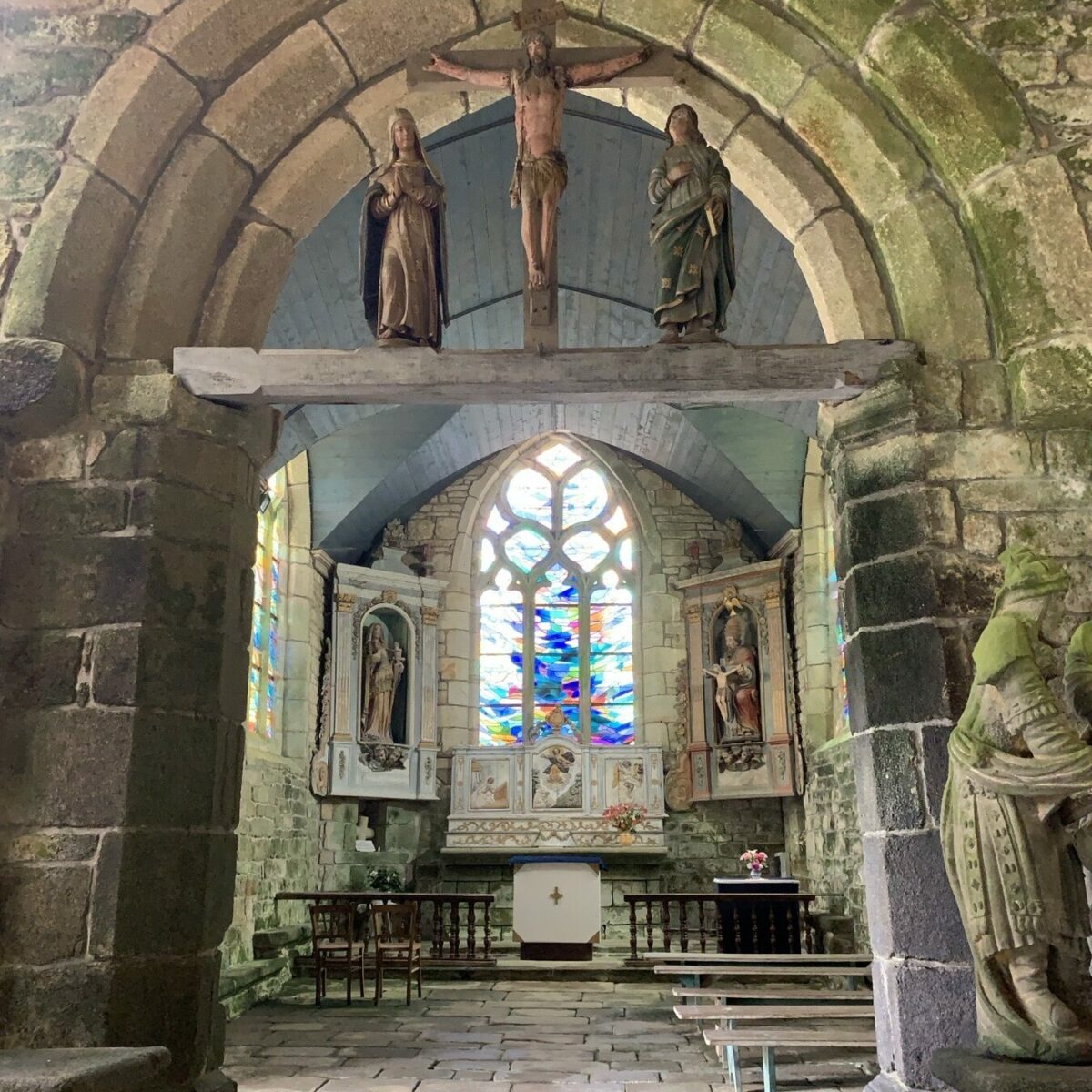Quimper is officially recognized as a City of Art and History, thanks to the quality of its architectural heritage: the St. Corentin Cathedral, the 16th and 17th-century houses that line the ramparts and quays of the Odet River, the Locmaria district, museums, lively streets, and bustling shopping areas. Stroll through the medieval city and across the 19th-century footbridges.
Quimper & Its Surroundings
The Soul of Finistère
A city of art and history,
between stone and ocean
The House of Captain Lala Saul
Address: 27 rue de Concarneau
29000 Quimper
Locronan : 30 minutes
Located on a mountain within an exceptional natural heritage, just 5 km from the sea, this medieval town is one of the most prestigious sites in Brittany due to its architectural quality. Its labels are proof of this: Petite Cité de Caractère in Brittany and one of the Most Beautiful Villages of France. It is home to many craft artisans.
Pays de Douarnenez : 30 minutes
Douarnenez, once the sardine capital, represents, on one hand, a picturesque urban heritage made up of old canneries, factory owners’ houses, and homes of fisher families and sardine factory workers. On the other hand, seaside villas, ranging from the most imposing to the most modest, line the Tréboul district.
Le Cap-Sizun & la Pointe du Raz : 1 hour
The Cap-Sizun offers a concentrated experience of Brittany in a wild and preserved area: white sandy beaches, breathtaking viewpoints over the Iroise Sea, and rugged, unspoiled cliffs. With the iconic Pointe du Raz, the main cliffs of Cap Sizun form the “Grand Site de France.”
Pont l’Abbé & le Pays Bigouden : 20 minutes
The Pays Bigouden is a land of character and traditions, known for its traditional headdress, but it offers much more. Pont-l’Abbé, with its castle and inhabited bridge, is a keeper of these traditions. It is truly a land of fishermen, with its four lively ports: Le Guilvinec, Loctudy, Saint Guénolé-Penmarc’h, and Lesconil.
Pays de Fouesnant & Bénodet : 25 minutes
Fouesnant and the Glénan Islands will surprise you with the diversity of their charms: rugged coastlines, long sandy beaches, and hiking trails along the legendary GR34. Let yourself be charmed by the beautiful seaside resort of Bénodet, with its cornice, beaches, as well as its casino and thalassotherapy center.
Concarneau : 30 minutes
A port town and former stronghold of Brittany, Concarneau has managed to preserve its rich architectural heritage. Sheltered within the fortifications of the Ville Close, trawlers and coastal fishing boats unload their catch near the canning factories and shipyards. Its bay hosts a seaside resort with fine sandy beaches.
Pont Aven : 30 minutes
Follow in the footsteps of Paul Gauguin. Picture him on the port, along the banks of the Aven River, admiring the mills that line the way. You’ll understand why he fell so deeply in love with this artist’s town, which he helped make known across the seas. For a delightful break, don’t miss the authentic galettes.
La presqu’île de Crozon : 1 hour
Breathtaking sites that you’d never want to forget: this peninsula is magnificent from every angle. And this beauty is nothing new: megaliths, the Vauban tower (a UNESCO heritage site), and the fortifications route all tell a story of history. For those seeking thrills, rock climbing, canyoning, or sea fishing are all waiting for you.

The episcopal city and
the ramparts of Quimper,
a City of Art and History.
The birth of Quimper, City of Art and History, is right before your eyes. The St. Corentin Cathedral and the Bishops’ Palace stand proudly in St. Corentin Square, the vital heart of the walled city.
In 1239, Bishop Reynaud decided to build St. Corentin Cathedral, using the foundations of an ancient Romanesque church. Attached to the cathedral, the Bishops’ Palace houses the Departmental Breton Museum. During the Ancien Régime, this palace served as the residence of the Bishop of Cornouaille, who was also the lord of the walled city of Quimper. Up until the mid-19th century, successive bishops focused on remodeling, enlarging, and restoring this residence. The current building was constructed between 1645 and 1647 by the Quimper architect Bertrand Moussin.
The city of the Dukes of Brittany
A belt of ramparts delineates the initial core of the city. Within this restricted space, which concentrates all the city’s activities, were built the houses of the canons and those of the bourgeois.
The timber-framed houses of Quimper, a City of Art and History, are an integral part of the urban landscape. A testament to medieval craftsmanship, these buildings have marked the centuries, from the 14th to the 19th, when the techniques and usage were gradually abandoned. A true wooden puzzle, these houses are the pride of most Breton towns. Thanks to them, it is possible to imagine Quimper during a time when two powers rivaled: the bishop within the walled city and the dukes on the other bank of the Steïr River.


The city of the Dukes of Brittany
A belt of ramparts delineates the initial core of the city. Within this restricted space, which concentrates all the city’s activities, were built the houses of the canons and those of the bourgeois.
The timber-framed houses of Quimper, a City of Art and History, are an integral part of the urban landscape. A testament to medieval craftsmanship, these buildings have marked the centuries, from the 14th to the 19th, when the techniques and usage were gradually abandoned. A true wooden puzzle, these houses are the pride of most Breton towns. Thanks to them, it is possible to imagine Quimper during a time when two powers rivaled: the bishop within the walled city and the dukes on the other bank of the Steïr River.

Locmaria, the original site of Quimper,
City of Art and History
The Locmaria district is located on the left bank of the Odet River, to the south of the walled city and St. Corentin Cathedral. With the establishment of the Quimper pottery, the working-class character of the area became more pronounced. Locmaria turned into a popular district, filled with many small houses and cottages, along with its church (11th and 12th centuries) and its priory (17th and 18th centuries), which housed a community of Benedictine nuns.
The Abbey of Locmaria is the oldest Christian establishment in the city. The Notre-Dame abbatial church is a perfect example of the early Romanesque art in Brittany.
The Saint Corentin Cathedral of Quimper,
the jewel of Breton Gothic art
In 1239, Bishop Raynaud decided to build the current cathedral, using the foundations of an earlier Romanesque cathedral. In 1410, the vaults of the choir were completed, and stained glass windows were installed in the high windows. In 1424, Bishop Bertrand de Rosmadec began the construction of the nave and the two towers of the facade.
From the 1850s, the Quimper architect Joseph Bigot began the restoration of the building, mainly focusing on the decoration of the chapels and the commissioning of new stained glass windows that had been destroyed during the French Revolution. His most spectacular achievement remains the completion of the two towers, with the construction of the spires between 1854 and 1856, funded by the people of Quimper.
From 1989 to 1999, a restoration campaign revealed the cathedral’s appearance at the end of the 15th century: the restoration of the interior polychromes, with the reappearance of the ribs treated in yellow ochre and red ochre, and the general limewashing of the stone facings.


The Saint Corentin Cathedral of Quimper,
the jewel of Breton Gothic art
In 1239, Bishop Raynaud decided to build the current cathedral, using the foundations of an earlier Romanesque cathedral. In 1410, the vaults of the choir were completed, and stained glass windows were installed in the high windows. In 1424, Bishop Bertrand de Rosmadec began the construction of the nave and the two towers of the facade.
From the 1850s, the Quimper architect Joseph Bigot began the restoration of the building, mainly focusing on the decoration of the chapels and the commissioning of new stained glass windows that had been destroyed during the French Revolution. His most spectacular achievement remains the completion of the two towers, with the construction of the spires between 1854 and 1856, funded by the people of Quimper.
From 1989 to 1999, a restoration campaign revealed the cathedral’s appearance at the end of the 15th century: the restoration of the interior polychromes, with the reappearance of the ribs treated in yellow ochre and red ochre, and the general limewashing of the stone facings.
Saint Corentin
In the time of King Gradlon, Saint Corentin settled as a hermit in what is now the town of Plomodiern to dedicate himself entirely to prayer. The saint performed many miracles
during this time.
One day, Gradlon, the King of Cornouaille, went hunting with his entourage in the dense forest that once covered the Porzay plain. The king got lost and eventually found himself, exhausted and hungry, at Corentin’s hermitage. Corentin performed the miracle of feeding the entire group with just a single small fish. This was the fish he ate daily: every day, he would take a slice, then place the fish back in the water, where it would immediately regenerate.
The king, amazed by this miracle, decided to give his castle near the confluence (Quimper) to Corentin and asked him to become the first bishop of his kingdom.
Quimper,
capital of earthenware
A love story spanning over 300 years
The story of faïence begins in 1690 with the arrival of Jean-Baptiste Bousquet, who left his hometown near Marseille to settle as a master pipe maker near the Priory of Locmaria.
He earns an honest living there, without competition, and benefits from the proximity of the port, which facilitates the transport of raw materials and finished products. These factors will convince his son Pierre, a faïencier in Marseille, to settle in 1707.
At the beginning of the 20th century, the two great pottery factories facing each other were HB (Hubaudière-Bousquet) and Henriot. Both potteries’ participation in the 1925 International Exhibition of Decorative Arts was a success. The revival of Breton culture was also, from that point onward, reflected in their workshops.

Discover the history of faience
by visiting the Faience Museum of Quimper.
Henriot-Quimper is one of the oldest French companies, founded in 1690 during the era of royal manufactories. Recognized as an “Entreprise du Patrimoine Vivant” (Living Heritage Company), it is the sole heir to the prestigious heritage of Quimper pottery and a unique savoir-faire, renowned worldwide. Everything here is handmade, from the creation of the pieces to the freehand decoration: tableware, interior decoration, limited-edition reissues, as well as a line of elegant faïence jewelry, and of course, the famous personalized name bowl invented in the workshops of the pottery in the 1930s.
Guided tours of the Henriot-Quimper pottery workshops are available from April to September. For more information, please contact the Tourist Office or the Pottery directly.
The factory shop, on the other hand, is open all year round.
Faïencerie Henriot-Quimper
Place Bérardier – Locmaria – 29000 Quimper
Tel: 02 98 90 09 36 – www.henriot-quimper.com

